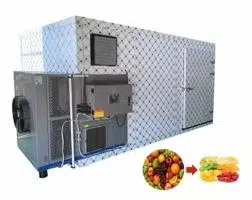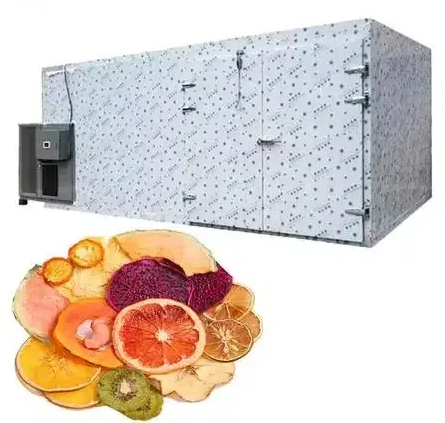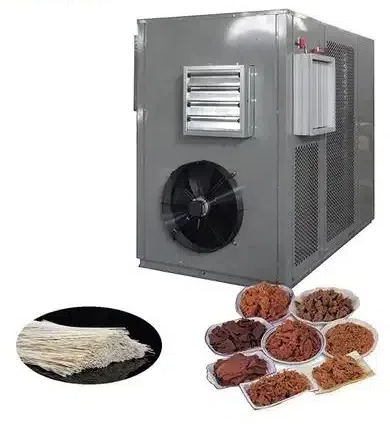
Content Menu
● Understanding Food Drying Technology
>> Types of Food Dryers
● How Do Heat Pump Dryers Work?
● How Do Condenser Dryers Work?
● Key Differences Between Heat Pump Dryers and Condenser Dryers
● Applications in Food Drying
>> Heat Pump Dryers in Food Processing
>> Condenser Dryers in Food Processing
● Choosing Between Heat Pump and Condenser Dryers
● Advantages of Heat Pump Technology
● Advantages of Condenser Technology
● Considerations When Implementing Food Drying Solutions
>> Quality Control
>> Regulatory Compliance
>> Training Staff
>> Maintenance Protocols
● Future Trends in Food Drying Technology
● Conclusion
● FAQ
>> 1. What is the main difference between heat pump dryers and condenser dryers?
>> 2. Are heat pump dryers more energy-efficient than condenser dryers?
>> 3. Which type of dryer is better for delicate foods?
>> 4. Can I use a condenser dryer for food processing?
>> 5. What factors should I consider when choosing between these two types of dryers?
In the world of drying technology, two popular types of dryers often come into discussion: heat pump dryers and condenser dryers. Both are designed to efficiently remove moisture from various materials, but they operate using different principles and technologies. This article will explore the differences and similarities between these two types of dryers, focusing specifically on their applications in food drying.

Understanding Food Drying Technology
Food drying is a crucial process in food preservation, extending shelf life, and maintaining nutritional quality. The method of drying can significantly affect the final product's taste, texture, and safety.
Types of Food Dryers
- Convection Dryers: Use hot air to circulate around the food.
- Freeze Dryers: Remove moisture by freezing the food and then applying a vacuum.
- Heat Pump Dryers: Utilize a heat pump system to transfer heat and moisture.
- Condenser Dryers: Use a heat exchanger to condense moisture from the air.
How Do Heat Pump Dryers Work?
Heat pump dryers operate by transferring heat from one place to another using a refrigerant. Here's how they function:
1. Evaporation: The refrigerant absorbs heat from the surrounding environment as it evaporates.
2. Compression: The gaseous refrigerant is compressed, raising its temperature.
3. Condensation: The hot gas is then passed through a condenser where it releases heat to the drying chamber, warming the air inside.
4. Cooling: The refrigerant cools down and returns to its liquid state, ready to repeat the cycle.
This process allows heat pump dryers to operate at lower temperatures while still effectively removing moisture from food products.
How Do Condenser Dryers Work?
Condenser dryers function differently:
1. Heating Element: They use a heating element to warm the air inside the drum.
2. Moisture Removal: As warm air circulates through the dryer, it absorbs moisture from the clothes or food.
3. Condensation: The moist air is then passed through a heat exchanger where it cools down, causing the moisture to condense into water.
4. Water Collection: The condensed water is collected in a tank or drained away.
Condenser dryers are typically more straightforward in design compared to heat pump dryers but may consume more energy due to higher operating temperatures.
Key Differences Between Heat Pump Dryers and Condenser Dryers
| Feature | Heat Pump Dryer | Condenser Dryer |
| Energy Efficiency | Highly efficient, uses lower temperatures | Less efficient, operates at higher temperatures |
| Operating Temperature | Lower temperature settings | Higher temperature settings |
| Moisture Removal | Uses refrigerant cycle for moisture removal | Uses heated air for moisture removal |
| Installation | Requires more space due to additional components | Generally easier to install |
| Cost | Higher initial investment | Lower initial investment |
Applications in Food Drying
Both heat pump and condenser dryers have unique advantages when it comes to food drying:
Heat Pump Dryers in Food Processing
- Gentle Drying: Ideal for delicate foods like fruits and vegetables that require careful handling.
- Nutrient Retention: Operate at lower temperatures, preserving vitamins and minerals better than traditional methods.
- Energy Savings: More energy-efficient over time due to lower operating costs.
- Versatility: Can be used for a wide range of products including herbs, spices, and even meat products when configured correctly.

Condenser Dryers in Food Processing
- Versatility: Suitable for various food types, including meat and fish.
- Faster Drying Times: Higher temperatures can lead to quicker drying cycles.
- Cost-Effective for Large Batches: Often more affordable for initial setup when processing large quantities of food.
- Ease of Maintenance: Simpler design allows for easier cleaning and maintenance routines.
Choosing Between Heat Pump and Condenser Dryers
When deciding between a heat pump dryer and a condenser dryer for food processing, consider factors such as:
- Type of Food Being Dried: Delicate foods may benefit from heat pump technology while denser foods might be dried effectively with condenser dryers.
- Energy Costs: Evaluate long-term energy usage versus initial investment costs; heat pump dryers may save more money over time despite higher upfront costs.
- Space Availability: Ensure adequate space for installation based on dryer type; heat pump systems may require more room due to their complexity.
- Desired Moisture Content: Different foods require different moisture levels; understanding these needs can guide your choice of dryer.
Advantages of Heat Pump Technology
Heat pump technology offers several benefits:
- Eco-Friendly: Reduced energy consumption leads to lower carbon footprints, making them an environmentally friendly option for food processors.
- Consistent Results: Provides uniform drying conditions that result in high-quality products with minimal variability in moisture content.
- Flexibility in Operation: Can be adjusted for different moisture levels and drying times, allowing processors to tailor their operations according to specific product requirements.
- Reduced Risk of Over-Drying: Lower operational temperatures help prevent over-drying or cooking of sensitive products like fruits and vegetables.
Advantages of Condenser Technology
Condenser dryers also have their strengths:
- Simplicity: Easier maintenance due to straightforward design; fewer moving parts mean less potential for mechanical failure.
- Immediate Results: Faster drying times can be beneficial for urgent processing needs or high-demand products requiring quick turnaround times.
- Lower Initial Costs: Generally more affordable than heat pump systems, making them accessible for smaller operations or startups looking to minimize capital expenditure.
Considerations When Implementing Food Drying Solutions
When implementing any food drying solution, several factors should be considered:
Quality Control
Maintaining consistent quality during the drying process is vital. Both types of dryers should be equipped with precise temperature controls and humidity monitoring systems to ensure optimal conditions are maintained throughout the drying cycle.
Regulatory Compliance
Food safety regulations must be adhered to during processing. Ensure that all equipment meets local health standards and that proper sanitation practices are followed during operation.
Training Staff
Proper training for staff operating these machines is essential. Understanding how each type of dryer functions will help operators troubleshoot issues quickly and maintain high-quality output consistently.
Maintenance Protocols
Establishing regular maintenance schedules will prolong equipment lifespan and ensure efficiency remains high. This includes cleaning filters, checking seals, and ensuring that all components are functioning correctly.
Future Trends in Food Drying Technology
As technology continues to evolve, so too do the methods used in food drying:
- Smart Technology Integration: Increasingly, manufacturers are incorporating IoT (Internet of Things) capabilities into their drying equipment. This allows remote monitoring and control via smartphones or computers, improving efficiency and reducing downtime through predictive maintenance alerts.
- Sustainability Focus: With growing concerns about environmental impact, manufacturers are developing more sustainable practices within their operations. This includes using renewable energy sources or designing equipment that minimizes waste production during the drying process.
- Enhanced Automation: Automation is becoming more prevalent in food processing facilities. Automated loading/unloading systems paired with advanced sensors can optimize drying cycles further while reducing labor costs associated with manual operations.
Conclusion
In conclusion, while heat pump dryers and condenser dryers serve similar purposes in food drying processes, they are not the same. Each type has its unique advantages and applications depending on the specific needs of food processors. Heat pump dryers are more energy-efficient and better suited for delicate foods, while condenser dryers offer faster drying times and simpler maintenance. Ultimately, the choice between these two technologies will depend on various factors including energy costs, type of food being dried, operational requirements, quality control measures, regulatory compliance needs, staff training protocols, maintenance schedules, and future trends in technology adoption within your facility.

FAQ
1. What is the main difference between heat pump dryers and condenser dryers?
Heat pump dryers use a refrigerant cycle for moisture removal at lower temperatures, while condenser dryers use heated air at higher temperatures for faster drying times.
2. Are heat pump dryers more energy-efficient than condenser dryers?
Yes, heat pump dryers are generally more energy-efficient because they operate at lower temperatures and recycle heat within the system.
3. Which type of dryer is better for delicate foods?
Heat pump dryers are better suited for delicate foods as they provide gentle drying conditions that preserve nutrients better than higher temperature methods.
4. Can I use a condenser dryer for food processing?
Yes, condenser dryers can be used in food processing but may not retain nutrients as effectively as heat pump dryers due to higher operating temperatures.
5. What factors should I consider when choosing between these two types of dryers?
Consider factors such as the type of food being dried, energy costs, space availability for installation, desired drying times, quality control measures required during processing when making your decision.












